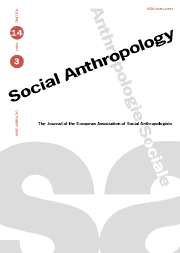No CrossRef data available.
Remembering the future: Slavery, youth and masking in the Cameroon Grassfields
Published online by Cambridge University Press: 24 February 2006
Abstract
This article examines the ful[ecy ]ga dance performed by the palace kwifn society in the Cameroon Grassfields chiefdom of Oku. The argument is made that many aspects of the dance evoke the capture and detention of slaves and the forced labour of the colonial era, and that while political elites use the dance to project the political violence of the palace onto exogenous forces, the young cadets re-appropriate it to draw connections between the past and present political role of the palatine elite. Highlighting the psychological effects of dissociation and belatedness in the light of the traumatic effects of the salve trade, the article proposes that the fragmentation of chronological time and linear history associated with trauma may not only represent pathological symptoms, but also a means of bearing witness to political violence and domination – be they historical or contemporary.
- Type
- Research Article
- Information
- Copyright
- Cambridge University Press 2006




